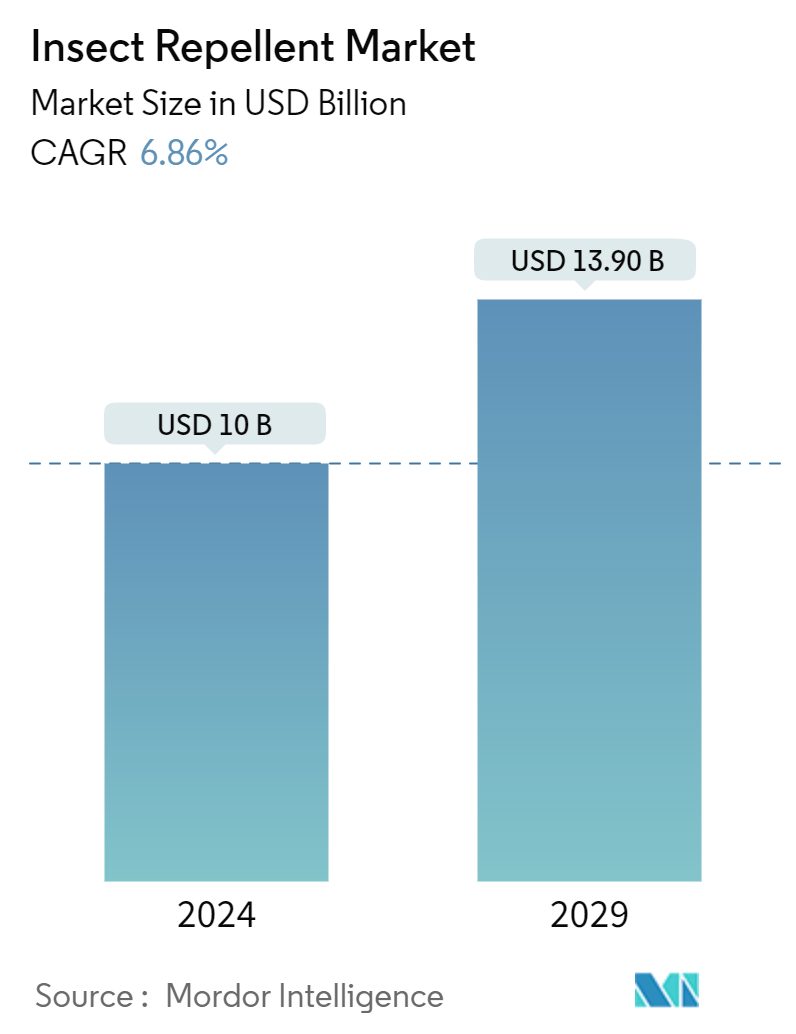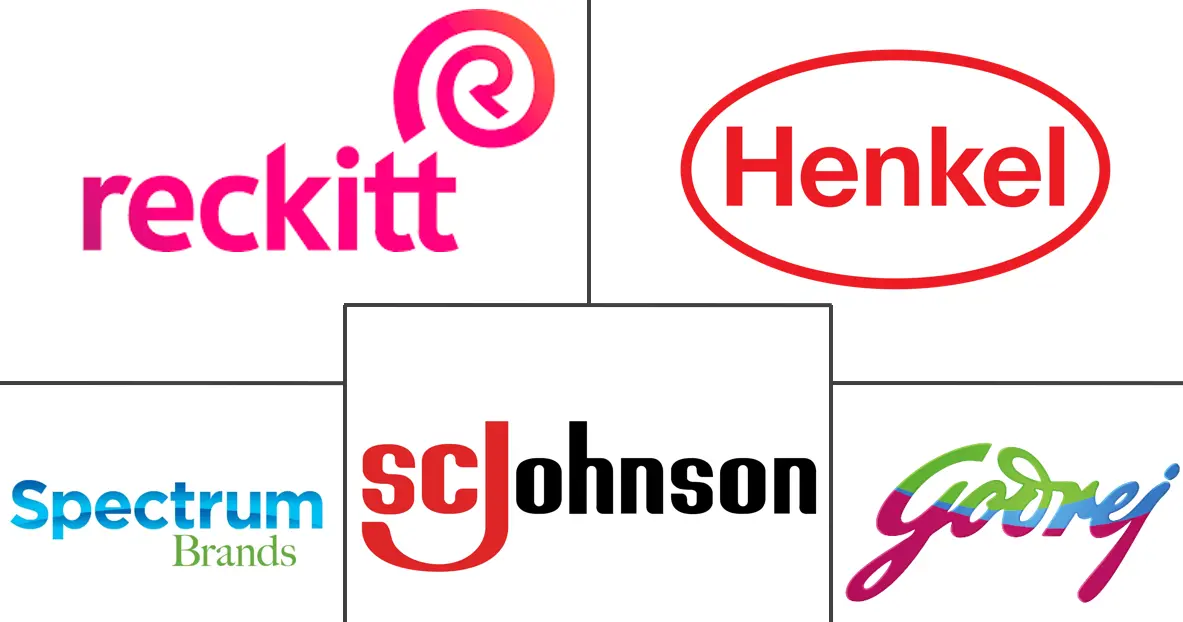Market Size of Insect Repellent Industry

| Study Period | 2019 - 2029 |
| Market Size (2024) | USD 10 Billion |
| Market Size (2029) | USD 13.93 Billion |
| CAGR (2024 - 2029) | 6.86 % |
| Fastest Growing Market | Asia-Pacific |
| Largest Market | Asia Pacific |
| Market Concentration | Low |
Major Players
*Disclaimer: Major Players sorted in no particular order |
Insect Repellent Market Analysis
The Insect Repellent Market size is estimated at USD 10 billion in 2024, and is expected to reach USD 13.90 billion by 2029, growing at a CAGR of 6.86% during the forecast period (2024-2029).
The growing threat of diseases, such as dengue, malaria, chikungunya, Zika virus, and yellow fever, is expected to boost the demand for insect repellents during the forecast period. Government initiatives being increasingly undertaken for disease control, rising health awareness among people, and the affordable costs of these products are among the major factors propelling the demand for insect repellents across the world. Also, the wide range of insect repellents in different price ranges has made them more easily accessible and affordable for a large consumer base. There has been a rise in the adoption of insect repellents based on natural ingredients. The adoption of such insect repellents is increasing among consumers to avoid problems such as skin rashes and allergies, among others.
Manufacturers are coming up with various products that are reducing the harmful effects of repellents due to the content of DEET in them, which, in turn, is anticipated to boost the insect repellent market’s growth significantly during the forecast period. For instance, in July 2023, Flora-scent Organics launched an innovative mosquito-repellent incense stick. As per the company, it is an all-natural product made using a blend of organic plant oils that are well-known for their insect-repellent qualities, but it contains no citronella. With the growing incidences of health hazards caused by such chemical-based insect repellents, consumer preferences have begun to switch toward herbal-based insect repellents. Presently, people in developed regions worldwide have started using neem-based sprays, creams, oils, citronella oil, birch tree bark, and other plant-based ingredients. Key players in the market include Dabur International, Reckitt Benckiser Group PLC, Godrej Consumer Products Limited, SC Johnson & Son Inc., Jyothy Laboratories, Spectrum Brand Holdings Inc., and Genesis Group. The players operating in the market have been adopting strategies, such as new product launches, agreements, collaborations, and acquisitions, to gain a stronger foothold in the market.
Insect Repellent Industry Segmentation
Insect repellents are agents used to protect the body from the bites of insects that can cause local or systemic effects. While some bites cause only local skin irritation, some can cause severe illnesses and possibly death as the insects act as carriers or vectors of diseases. Thus, insect repellents protect against all insect bites and prevent diseases from occurring. The insect repellent market is segmented based on product type, distribution channel, category, and geography. By product type, the market is segmented into body work insect repellents (cream/lotion and oil) and other insect repellants. The other insect repellants segment is further sub-segmented into coil, liquid vaporizer, spray/aerosol, bait, and other insect repellants (chalk, powder, etc.). By distribution channel, the market is segmented into offline retail stores and online retail stores. By category, the market is segmented into natural insect repellent and conventional insect repellent. By geography, the market is segmented into North America, Europe, Asia-Pacific, South America, and Middle East and Africa. The market sizing has been done in value terms in USD for all the abovementioned segments.
| Product Type | |||||||
| Body Work Insect Repellents (Cream/Lotion and Oil) | |||||||
|
| Distribution Channel | |
| Offline Retail Stores | |
| Online Retail Stores |
| Category | |
| Natural Insect Repellent | |
| Conventional Insect Repellent |
| Geography | |||||||||
| |||||||||
| |||||||||
| |||||||||
| |||||||||
|
Insect Repellent Market Size Summary
The insect repellent market is poised for significant growth over the forecast period, driven by increasing health concerns related to vector-borne diseases such as dengue, malaria, and Zika virus. The market's expansion is supported by government initiatives aimed at disease control, heightened health awareness, and the affordability of insect repellent products. The availability of a diverse range of repellents, including those based on natural ingredients, has made these products more accessible to a broad consumer base. Manufacturers are innovating to reduce the adverse effects of traditional chemical-based repellents, such as those containing DEET, by introducing alternatives like picaridin and herbal formulations. This shift towards safer and more environmentally friendly options is gaining traction, particularly in developed regions where consumers are increasingly opting for plant-based ingredients.
In the Asia-Pacific region, countries like China and India are witnessing a surge in the adoption of insect repellents due to rising disposable incomes, increased health awareness, and effective marketing campaigns. The popularity of cost-effective products, such as coil repellents, is particularly notable in rural areas, where offline distribution channels remain dominant. The market is characterized by intense competition, with major players like Spectrum Brands, Henkel AG, Reckitt Benckiser, and Godrej Group leading the charge through product innovations and strategic expansions. These companies are focusing on enhancing their product portfolios and global presence to capture a larger market share. The ongoing development of biodegradable and sustainably sourced repellents aligns with the growing consumer demand for eco-friendly solutions, further propelling market growth.
Insect Repellent Market Size - Table of Contents
-
1. MARKET DYNAMICS
-
1.1 Market Drivers
-
1.1.1 Surge in Product Innovation
-
1.1.2 Increasing Government Initiatives and Extensive Promotions by Market Players
-
-
1.2 Market Restraints
-
1.2.1 Safety Concerns Associated with the Usage of Insect Repellents
-
-
1.3 Porter's Five Forces Analysis
-
1.3.1 Threat of New Entrants
-
1.3.2 Bargaining Power of Buyers/Consumers
-
1.3.3 Bargaining Power of Suppliers
-
1.3.4 Threat of Substitute Products
-
1.3.5 Intensity of Competitive Rivalry
-
-
-
2. MARKET SEGMENTATION
-
2.1 Product Type
-
2.1.1 Body Work Insect Repellents (Cream/Lotion and Oil)
-
2.1.2 Other Insect Repellents
-
2.1.2.1 Coil
-
2.1.2.2 Liquid Vaporizer
-
2.1.2.3 Spray/Aerosol
-
2.1.2.4 Bait
-
2.1.2.5 Other Insect Repellents
-
-
-
2.2 Distribution Channel
-
2.2.1 Offline Retail Stores
-
2.2.2 Online Retail Stores
-
-
2.3 Category
-
2.3.1 Natural Insect Repellent
-
2.3.2 Conventional Insect Repellent
-
-
2.4 Geography
-
2.4.1 North America
-
2.4.1.1 United States
-
2.4.1.2 Canada
-
2.4.1.3 Mexico
-
2.4.1.4 Rest of North America
-
-
2.4.2 Europe
-
2.4.2.1 United Kingdom
-
2.4.2.2 Germany
-
2.4.2.3 Spain
-
2.4.2.4 France
-
2.4.2.5 Italy
-
2.4.2.6 Russia
-
2.4.2.7 Rest of Europe
-
-
2.4.3 Asia-Pacific
-
2.4.3.1 China
-
2.4.3.2 Japan
-
2.4.3.3 India
-
2.4.3.4 Australia
-
2.4.3.5 Rest of Asia-Pacific
-
-
2.4.4 South America
-
2.4.4.1 Brazil
-
2.4.4.2 Argentina
-
2.4.4.3 Rest of South America
-
-
2.4.5 Middle East and Africa
-
2.4.5.1 South Africa
-
2.4.5.2 United Arab Emirates
-
2.4.5.3 Rest of Middle East and Africa
-
-
-
Insect Repellent Market Size FAQs
How big is the Insect Repellent Market?
The Insect Repellent Market size is expected to reach USD 10 billion in 2024 and grow at a CAGR of 6.86% to reach USD 13.93 billion by 2029.
What is the current Insect Repellent Market size?
In 2024, the Insect Repellent Market size is expected to reach USD 10 billion.

